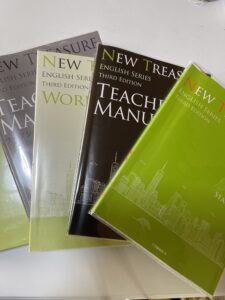奈良学園前と西宮夙川にある英語専門塾です。多くの生徒がニュートレジャーやプログレスなどの教科書を使っています。教室ではオリジナルのプリントを作って対応しております。その中から少しずつアップしていきます。
いよいよニュートレジャーのステージ2も第3版がでましたね。
ニュートレジャー ステージ2 レッスン4リードの和訳です。
自習勉強にお役立てください。
60 Takashi’s Speech about the Sanshin ❶
Today, I ( ) ( ) ( ) about the sanshin. This is a musical instrument from Okinawa. At parties or festivals in Okinawa, people often sing songs and play traditional music ( ) the sanshin. The shape of the sanshin is ( ) ( ) ( ) of the shamisen. Both of them have three strings. The sanshin’s three strings are symbols of “ ( ),” “( )” and ( ).” Today, the sanshin is a symbol of peace in Okinawa.
私は三線については話したいと思います。これは沖縄の楽器です。沖縄ではパーティや、お祭りで、人々は三線にあわせて歌をうたったり伝統的な音楽を演奏します。三線の形は三味線のそれと似ています。両方とも3本の弦があります。サンシンの三本の弦は『平和』、『質』、『自由』の象徴です。今は、サンシンは沖縄の平和の象徴です。
When the sanshin came from China to Okinawa in the thirteenth or fourteenth century, the people of Okinawa ( ) ( ) ( ) the sanshin.
Their work( ) the farms or( ) ( ) sea was very hard, but ( ) ( ) ( ) the sound of the sanshin after work was great fun for the people of Okinawa. The people of Okinawa played the sanshin every night, and each family kept their own sanshin at home.
三線が中国から沖縄に13世紀か14世紀に来たとき、沖縄の人々は三線を弾き始めました。農場での仕事や海に出る仕事はとても厳しかった。しかし、仕事の後に三線の音に合わせて踊ることは沖縄の人々にとってもとても楽しかった。沖縄の人々は毎晩三線を演奏しました、そしてそれぞれの家族が家に彼ら自身の三線を持っていました。
p.61 Takashi’s Speech about the Sanshin ❷
During the Pacific War, there was a lot of fighting and many people died in Okinawa. Life for the people of Okinawa was very hard, so they sang traditional songs and played the sanshin ( ) ( ) ( )their family. The sanshin ( ) ( ) ( ) people in those times.
太平洋戦争の間、多くの戦いがあり沖縄では多くの人が亡くなった。沖縄の人々の生活はとても厳しかった、だから、彼らは家族を励ますために、伝統的な歌を歌ったり、三線を弾いた。三線は当時の人々に希望を運んだ。
For several years after the war, life in Okinawa was still very difficult. Many people lost their homes during the war and had ( ) ( ) ( ) or wear. Some people also lost their sanshin. But the people didn’t ( ) ( ). ( ) ( ) ( ) , a new ( ) ( ) sanshin became popular in Okinawa. A lot of people were poor, so they made sanshin ( ) ( ) ( ) old wood and empty cans and began to play them. People started to call this new instrument “kankara sanshin.” “Kankara” means “empty cans.” They could make their own kankara sanshin easily and cheaply. ( ) ( )the kankara sanshin the people of Okinawa found the strength to ( ) ( ) their hard life and to ( ) ( ) ( ) a new life.
戦争後数年間は、沖縄の生活は以前と厳しかった。多くの人が戦争中に家を失い、そして食べるものも着るものも持っていなかった。彼らの三線を失ってしまった人もいた。しかし、人々はあきらめなかった。当時、新しい種類の三線が沖縄では人気になった。多くの人が貧しかったので、彼らは三線は古木や空き缶で手作りし,そ『空き缶』という意味だ。彼らは自分たち自身のカンカラ三線を簡単に、安く作る事ができた。カンから三線のおかげで、沖縄の人々は困難な生活を乗り越える強さと新しい生活へと進み続ける強さを見つけた。
Takashi’s Speech about the Sanshin ❸ p.63
Today, ( ) the traditional sanshin and the kankara sanshin are popular ( ) people in Okinawa. A lot of musicians use the sanshin in their modern songs, so ( ) and ( ) people ( ) and outside Okinawa ( ) ( ) ( ) enjoy the sanshin. The sanshin has a long history, and the sound of the sanshin always ( ) joy ( ) the people of Okinawa. It will continue to ( ) ( ) ( ) ( ) in their lives.
今では、伝統的な三線とカンカラ三線両方が沖縄の人々の間で人気です。多くの音楽家たちが彼らの現代音楽に三線を使います。だから、沖縄の内外の人がどんどん三線を楽しめるようになるでしょう。三線は長い歴史をもっています、そして三線の音は沖縄の人々にいつも喜びを運んできます。それは生涯、重要な役割をはたし続けるでしょう。



